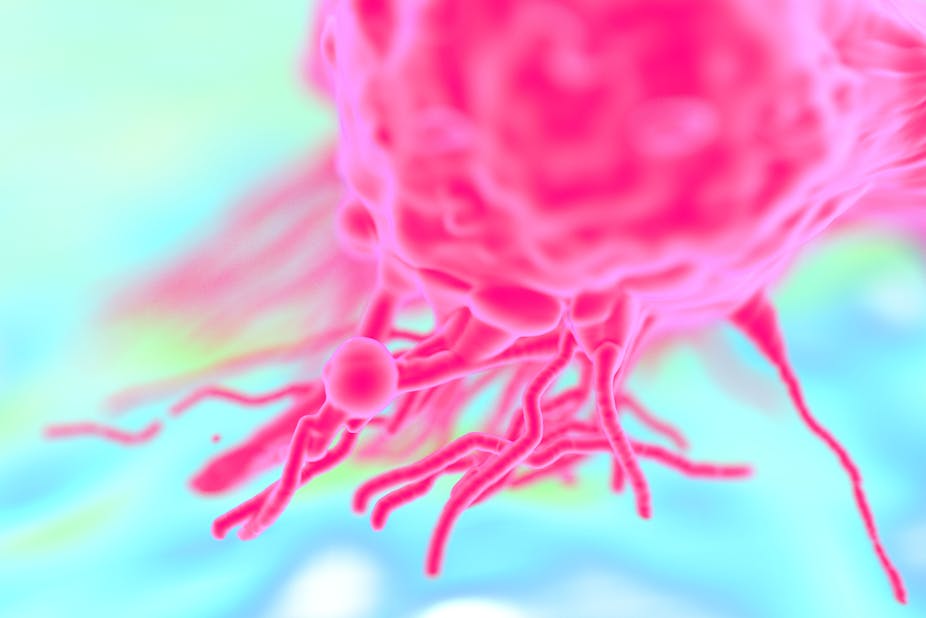Chemotherapy is a blunt weapon. It kills cancer cells and healthy ones, too. For this reason, scientists are looking to develop more targeted treatments – treatments that don’t create a lot of collateral damage. One strategy to fight cancer is to use drugs that block the cell molecules that pass on the signals that lead to cancer growth. Right now, understanding these “signalling pathways” is a hot area of cancer research.
Signalling pathways can be thought of as the language cells use to tell one another to perform a certain task, such as to grow or divide. These pathways involve a set of proteins that are activated in sequence.
For signalling to begin, an initial stimulus – usually a protein – needs to attach itself to the outer portion of a receptor which is embedded in the surface of the cell. When this happens the signal is transmitted into the cell via the portion of the receptor contained inside the cell. This then sets off a cascade of proteins “talking” to each other, which, in a healthy cell, leads to something useful happening.
Quality control
In healthy cells, these signals are kept in check by quality control mechanisms. Once the desired outcome of a signalling pathway has been achieved, the signal is abolished (a concept known as “negative feedback”). For example, once the pathway has exerted its effect, such as telling the cell to proliferate, the receptor which detects the initial stimulus may be tagged with multiple copies of a small protein called ubiquitin. Ubiquitin targets the receptor for destruction, which cuts the signal.

By contrast, cells in tumours may contain faults both in the main components of the signalling pathways and also in the mechanisms that facilitate negative feedback. These faults are usually in the form of mutations in key proteins which makes the afflicted component permanently active or inactive.
Alternatively, the mutations can result in certain proteins being created in the wrong amounts which means the activity of the protein is increased or decreased markedly. This leads to the signalling pathway or the associated quality control mechanisms, or both, being compromised. Depending on the function the protein or pathway normally fulfils, consequences may include uncontrolled cell growth and division – without the need for external stimuli – or a lack of “cell death” (a process normally required for killing defective cells).
These types of faults in signalling pathways are a major cause of tumour development, so we need specific anticancer drugs to target them.
No one-size-fits-all cure
The sheer number of signalling pathways, and the protein components that make up each pathway, mean the magnitude of “moving parts” within the cell makes it impractical to develop a one-size-fits-all cancer cure. Also, many signalling pathways can “cross-talk” with one another and therefore influence numerous aspects of cellular behaviour.
However, the range of these components facilitates “tailored” approaches where a single drug can be made to target a particular faulty protein within a given pathway.
Occasionally, it is seen that a specific rogue pathway can give rise to a specific cancer. In this way, certain drugs become crucial in treating certain cancers. By taking this approach there is a greater chance of hindering the proteins responsible for promoting tumours. This has been the idea for some of the existing targeted treatments.
One of the best known examples of this is the drug trastuzumab (Herceptin). Trastuzumab is used to treat advanced breast and stomach cancers caused by the over-expression of the HER2 protein. Trastuzumab attaches itself to this protein and prevents the initial protein stimulus from binding and stimulating cell proliferation. As a result, the pathway’s activity is markedly reduced which can alleviate the impact of excessive cell proliferation.
Another example is imatinib (Gleevec). Hailed as a “miracle drug”, imatinib is used to treat chronic myelogenous leukaemia. This cancer happens as a result of faulty genes that make a fusion protein (a protein made up of at least two genes which originally encoded different proteins) that is permanently switched on. This leads to the proliferation of white blood cells which can cause leukaemia.
Imatinib, in most cases, prevents the permanently active portion of the fusion protein, which can link to a variety of potential tumour-promoting signalling pathways, from interacting with an essential target molecule. In doing so, cell proliferation is reduced.
By studying precisely how such proteins function, misbehave and, in some cases, adapt to existing treatments, better and more streamlined drugs can be developed.
One of the most exciting avenues of research revolves around targeted therapies aimed at particular constituents of the many signalling pathways in our cells. The excitement arises from the potential this approach has in combating tumour cells without excessive collateral damage.
While there has been significant progress in this area already, as seen with trastuzumab and imatinib, given the multifaceted nature of cancer there is still scope, and a necessity, for further discoveries and targeted drugs to combat cancer. The myriad of signalling pathway proteins present make them attractive targets for future drug discoveries.
In this way, the hope is that one day we will be able to progress from targeted treatments to targeted cures.

